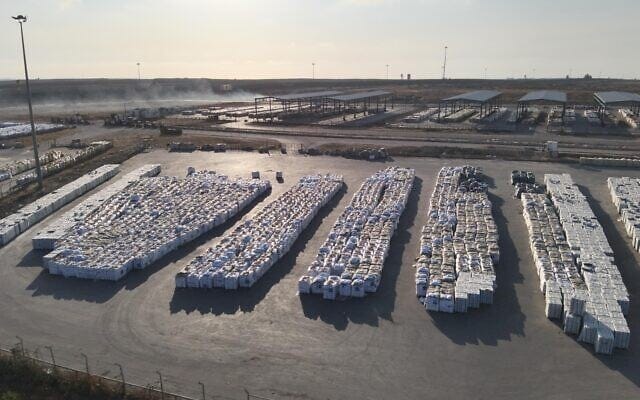
The headlines are damning. The pictures are worse. Only people devoid of empathy would not be moved. But converting feelings for the plight of Gazans into primarily blaming Israel for their suffering is not only wrong, but it serves to extend their suffering not alleviate it. Therefore, I think it wise to dig into these issues, as uncomfortable as they are.
Goals and Consequences
Israel has two primary goals in Gaza:
Ending Hamas’ rule over Gaza and extinguishing any chance that Hamas might return to power, and
Securing release of the estimated twenty live hostages held in dismal conditions by Hamas and recovery of the bodies of thirty dead ones.
Hamas has one primary goal composed of three parts—survival as an entity that can return to rule Gaza, rebuild its shattered terror army, and in the future launch new attacks on Israel.
Israel’s and Hamas’ goals are mutually exclusive.
If Israel meets its goals, the Gazan people will benefit because:
More food will enter Gaza that will be disseminated safely at multiple distribution points, rather than through trucks often hijacked by Hamas.
Gazans will no longer live under Hamas’ tyrannic rule.
Reconstruction will commence, fueled by massive cash inflows from Gulf State Arab countries and other sources.
If deradicalization of the educational systems is effective, coupled with rising living standards, hope and opportunity in Gaza might replace hatred and despair.
In addition:
A Gaza model might well be created that could be transplanted to the West Bank to the benefit of Palestinians living there.
Hamas, who was the perpetrator of the savage murder of 1,200 Israelis, rape of countless women including some tied to trees, genital mutilation, beheadings, and the kidnap of 251 Israelis will not have the opportunity to rinse and repeat as has been its history with the four prior wars Hamas instigated with Israel since coming to power in 2007.
The likelihood that Saudi Arabia will join the Abraham Accords will increase.
If Hamas meets its goals:
Nobody will provide the financial resources necessary to rebuild Gaza.
Gazans will continue to live in abysmal conditions and remain dependent on food handouts.
Hamas will have more, not less, ability to rule Gazans because it will control the means for disseminating humanitarian aid which will only serve to perpetuate individual obeisance to Hamas’ central mission to destroy Israel.
More terrorists will be created by squalor without end.
There will inevitably be another war between Israel and Hamas—this one perhaps even more deadly should Hamas obtain chemical or biological weapons.
It will be very difficult to convince Israelis to return to their homes in Israel near Gaza.
Terrorist groups worldwide will learn the lesson that taking hostages ensures their success. As such, no Jew, and likely no westerner, will be safe anywhere in the world.
The survival of Hamas might well empower and encourage other Jihadi forces in Arab nations, such as the U.A.E., Jordan, Egypt, and Saudi Arabia to overthrow their present governments to the detriment of Israel and all other democracies.
Saudi Arabia and other Arab nations will likely not join the Abraham Accords.
There is no chance that any agreement of any kind will be reached in the West Bank that will provide Palestinians living there some indicia of sovereignty because Israel will rightly not risk the rise of a second terrorist state on its borders.
Hamas will be rewarded for its savagery on October 7, 2023, and its promulgation and perverse use of Gazan suffering since that day.
Where Does Primary Fault Lie for Gazan Food Distress?
Squarely with Hamas. Hamas started this ongoing war, it perpetuates this war by holding onto Israeli hostages, and it interferes with the distribution of food to the Gazan people by:
Hijacking some shipments.
Stealing food from those that have procured it.
Selling food at high cost to fund continuing operations and recruitment—primarily in the form of salaries to its terrorist soldiers and hoarding other foodstuffs for its own people.
Intimidating those working with the Gaza Humanitarian Foundation (GHF) because they are employed by an entity that Hamas cannot penetrate.
Infiltrating the masses of Gazans attempting to secure food with only one goal in mind—creating mayhem that will put the lives of Israeli soldiers at risk that are tasked with defending the corridors leading to GHF food distribution centers in hopes of provoking an IDF defensive response that foreign media will report as being the fault of the IDF rather than having been instigated by Hamas.
Hamas’ lack of care for Gazan access to food should not surprise anyone. Since the start of the war, and long before, Hamas has consistently used unarmed Gazan men, women, and children as human shields because it sees in their innocence a potent propaganda weapon. That is why it placed its bases and weapon storage facilities under or in hospitals and schools, and even hid weaponry in children’s bedrooms—hoping to deter the IDF from destroying them and reaping the PR benefit if the IDF did at the cost of the blood of Gazan citizens. This ruthless behavior also manifests in Hamas’ refusal to allow Gazan noncombatants to seek protection from the fighting in its tunnels. As such, it does not take much cognitive effort to recognize that starvation in Gaza, whether real or believed, is Hamas’ ticket to survival which is its primary goal. In short, Hamas cares nothing for Gazans—only for itself.
Furthermore, this war ends the moment Hamas releases the remaining hostages, its leaders accept asylum in other countries, and its minions disarm. Israel has no desire to perpetuate the conflict, and even if it did, the international community (including the United States) would not allow it to. Therefore, the end of Hamas in Gaza would immediately lead to the beginning of the end of Gazan suffering. To promote anything else without prioritizing Hamas’ end dooms everyone in the region, Israelis and Gazans and neighboring Arab countries alike, to perpetual war and suffering the timing of which will be governed by the whims of ascendant and emboldened Jihadi movements, including Hamas, that use armed struggle to achieve their primary goal—establishment of Islamic states.
Blame Also Lies at The Doorstep of the United Nations
Since Hamas took over Gaza in 2007, United Nations (UN) agencies have allowed Hamas’s operatives to infiltrate their organizations that provide services in Gaza and have appointed leadership largely adverse to Israel’s interests. As a result, those agencies facilitated Hamas’ control of the populace. The same remained the case after October 7, 2023, as more than fifteen nations recognized when they suspended financing (some only temporarily) of The United Nations Relief and Works Agency for Palestine Refugees (UNRWA) in January 2024.
Nevertheless, various UN agencies and other organizations have delivered food and other humanitarian relief into Gaza since October 7, 2023. However, most all of it moved through a Hamas filter, from which much was taken by the terror organization to feed its terror army and to fund ongoing operations by selling it on the open market, often at inflated prices (I will address the ongoing dispute of this below). This prolonged Hamas’ staying power, resulting in the loss of more IDF soldier’s lives and making hostage release negotiations more difficult has and will cause increased suffering by Gazan citizenry caught between a merciless Hamas and a determined IDF. Nevertheless, despite allegations to the contrary, by and large there was no famine inside Gaza during the twenty months after the fighting started on October 7, 2023.
Then, during the sixty-day ceasefire at the beginning of 2025, Israel permitted massive amounts of food and other humanitarian supplies to pour into Gaza—enough by some estimates to feed the entire Gazan population for four to six months. However, in March, recognizing that Hamas had no intention of agreeing to disarm and relinquish control of Gaza, Israel—as it had a right to do under the terms of the ceasefire agreement—renewed its campaign against Hamas. Concurrently, recognizing that Gaza then had ample food supplies, Israel stopped the transport of more humanitarian aid into Gaza to prevent Hamas from syphoning off further supplies to support its war effort (I will address this in more detail in the section below dealing with Israeli fault).
However, Israel simultaneously recognized that the cutoff of humanitarian aid could not be permanent. Therefore, it knew it would need to find an alternative solution for providing humanitarian relief of Gazans. Out of that recognition sprang the Gaza Humanitarian Foundation (GHF), first organized in February 2025. Supported by Israel and the United States, the GHF began to distribute food in Gaza in May 2025. The GHF’s model is radically different from the UN model which:
At least informally coordinated with Hamas.
Delivered some food to a myriad of unaccountable warehouses and distribution locations
Allowed other food to be unloaded from individual trucks in a haphazard manner by armed groups (likely sometimes if not almost always affiliated with Hamas).
In contrast, GHF initiated its operations, and continues them to this day, in four secured locations—three in southern Gaza and one in central Gaza. Cumulatively, the GHF now disseminates an average of more than two million meals per day (the approximate population of Gaza) and since starting its operations has distributed one hundred million meals.
You might notice that at this point, the GHF does not distribute meals in northern Gaza. I could glibly say too bad since the IDF told Gazans to leave that area for safe zones in the central and southern coastal areas. But, although many honored the directive and evacuated the region to their personal benefit, many have remained due to their refusal to leave, their inability to do so, or Hamas’ intimidation. Thus, a humanitarian hole was left open that GHF cannot at this time shut but that needs to be closed. Why could the GHF not open a distribution center in northern Gaza? Because the IDF is not now operating there. And since the GHF model requires that the IDF provide security outside the distribution locations, and since Hamas has made clear that it will kill those that work with the GHF, that made it impossible for the GHF to distribute food in northern Gaza.
Thus, the UN and the many other NGOs that had been consistently operating in northern Gaza were needed to close the gap and Israel encouraged them to do so. Did they answer the call?
No!
Instead, all these supposedly caring agencies refused to cooperate with the GHF who daily implored them to send aid into northern Gaza and elsewhere where it was needed. So did Israel who did nothing to impede the flow in those areas other than to insist on inspecting the vehicles and checking routes. What were those organizations’ excuses for sitting on their thumbs and hurling accusations rather than delivering food? They amounted to hypocritical claims that working in parallel with the GHF would:
Politicize aid.
Undermine humanitarian neutrality.
Expose civilians to unsafe conditions.
Weaponize aid.
Be a “fig leaf for further violence and displacement.”
Really?
Assuming every accusation above was true (and they are demonstrably false or overblown, especially when one critically examines the operation the UN and the NGOs had been running before the GHF began its operations), it appears the UN and the NGOs would rather see Gazans starve than compromise their lofty ideals that they themselves never subscribed to when Hamas infiltrated their processes, when Hamas intimidated citizens, and when the organizations cooperated with Hamas despite having full knowledge that Hamas’ future intent is certainly not benign.
Now, it is a direct result of the UN’s and other NGO refusal to deliver its humanitarian aid that the hundreds of thousands in northern Gaza face severe food security issues and eventual starvation. Why? Because it was always understood that Gazans in the north would find it difficult or impossible to access GHF distribution centers in the center and the south. Thus, it was imperative that the UN and other NGOs continue to operate there, and Israel was willing to permit that even though that would give Hamas opportunities to fulfill its financial and caloric larder. But all those international entities that had served Gazans in the north for eighteen months refused to restart their operations in May. Thus, it is no wonder that anecdotally and logically it appears that most starvation concerns are primarily in northern Gaza (the UN World Food Program says that a quarter of Gaza’s population faces starvation—an amount that matches the estimated remaining population in northern Gaza). And it is important to recognize that the reason for that is the sanctimony of the international organizations.
Proof of this were the 950 truckloads of food aid, already inspected by Israel and free to be moved without restriction, that sat for an unconscionably long period inside Gaza at the Zikim and Kerem Shalom crossings, which Israel “opened and expanded for the express purpose of getting aid into Gaza.” Those trucks alone contained enough food to feed by my calculation all of Gaza for at least nine days or all those in northern Gaza for more than a month. Yet, the international agencies sitting high on their pompous horses, refused to collect the trucks and distribute the humanitarian aid in them—even though the GHF implored them to do so and offered to assist with the effort—which they rejected (as confirmed by the leader of the GHF in a Wall Street Journal and other reporting).
Instead, the international organizations launched a campaign to collapse the GHF and tar and feather Israel with claims of genocide and intentional creation of a famine. They did this by callously using their inactivity to increase Gazan suffering and then magnifying reporting and perceptions of Gazan suffering to achieve objectives that far more benefit the influence and continued existence of their organizations than the people they supposedly wish to serve. Furthermore, the timing of their accusations is suspicious coming concurrent to hostage negotiations in mid-July that appeared promising (even to Qatar and Egypt) until Hamas backtracked on earlier agreements and the negotiations broke down on July 24. Why did Hamas harden its negotiation stance on the verge of an agreement? I doubt it coincidental that Hamas did so after seeing the deluge of media condemnation inspired by the UN’s politicization of the humanitarian issue.
Fortunately, however, a few days ago these agencies began to pick up those 950 trucks, and many more are on the way. Was it because of any significant changes on the ground? Or was it because Israel released video highlighted their existence and western media came to inspect their idleness on July 24?
In all this web of intrigue, three things are certain:
Hamas sees humanitarian aid as its life blood for financing continuation its war.
Hamas sees dissemination of aid to through the GHF as a direct threat to its existence because it prevents Hamas from stealing the aid.
The UN and other international agencies are intentionally, by virtue of Hamas’ penetration of their relief arms in Gaza or by just turning a blind eye to facts on the ground, supporting Hamas by refusing to work in concert with the GHF to the benefit of Gaza’s people.
It’s shameful!
Egypt’s Callous Disregard to the Crisis Should Not Be Ignored
Egypt shares a border with southern Gaza. Across it, in the Sinai, there are countless square miles of scarcely inhabited land with ample access to the Mediterranean Sea. There, the international community could easily supply any number of Gazans with ample supplies of aid and temporary housing should they wish to go there.
But they cannot because Egypt will not let them in.
I can think of no other modern conflict where a neighboring country not involved in the fighting refuses to allow any refugees to enter to receive temporary sanctuary. If Egypt had chosen to do so, there would be no issue of famine, less civilian death due to the fighting, and Israel’s war with Hamas would come much faster to a conclusion. Yet Egypt refuses and the international community gives Egypt a pass.
Egypt’s stance is a humanitarian outrage that international pressure could change. But I guess outside forces would rather see Gazans suffer and starve for political reasons espoused by those with full bellies that languish in comparative luxury.
Media Complicity in the Food Crisis in Gaza
To some extent, western media’s failure is a symptom of our times. It is too quick to judge and too incentivized by economic realities that promote quickly issuing false or sensationalized stories based on biased or coerced reporters without first verifying reporting through objective analysis and cross-checking. Eyeballs rather than accuracy have become the order of the day. Then, when errors are made, sometimes corrections come far too late and are far too understated and buried to reverse the damage done.
Yet, something more is at play when it comes to Israel. By and large, western media fails to report Hamas’ actions and motives. Nor does it investigate the UN’s transgressions. Where are the articles in the New York Times or Washington Post or other mainstream media outlets, or even just one television expose on CNN or MSN, exploring how Gazan life would be better off without Hamas, and what the continued existence of Hamas would mean to Israel’s security or the impact of that on the Middle East? Nor do I generally see that balancing perspective when the purpose of the article or broadcast is to blame Israel exclusively for Gazan suffering. Instead, mainstream media all too often presents myopic versions of events, often based on falsified information from biased sources, with dramatized headlines designed to titillate not educate.
This phenomenon has occurred repeatedly since Hamas brutalized Israeli citizens on October 7. Furthermore, frequently pictures without context are used to tell a broad story in a manner that heightens emotion and limits reasons when really, at best, they present a small slice of a far more complicated mosaic. Two pictures are especially worthwhile noting because they are relevant to the discussion and their widespread dissemination in mainstream media was particularly egregious.
This first is of Osama al-Raqab taken in April 2025 and disseminated by many news outlets worldwide:
This is a real picture of a real boy who was in Gaza and is clearly suffering from malnutrition. What was missing from most accounts was the primary cause. Five-year-old Osama suffers from a serious genetic disorder, reported in some outlets as cystic fibrosis, that makes it difficult for him to gain weight and requires a specialized diet. Furthermore, through the joint efforts of Israel and Italy, he was one of several (perhaps 17) other Palestinians with serious medical conditions evacuated on, or about June 12, along with family members to Italy where he now is doing well. Did Osama suffer due to the war? For sure. But is his story the story of the general Palestinian populace? For sure not. Nevertheless, the BBC World ran his picture on July 23rd as part of its story about supposed mass starvation in Gaza and didn’t bother to inform readers of his unique condition that made him susceptible, that the picture was two months old, and that Israel had evacuated him for treatment.
The second picture is of Muhammad Zakariya Ayyoub al-Matouq:
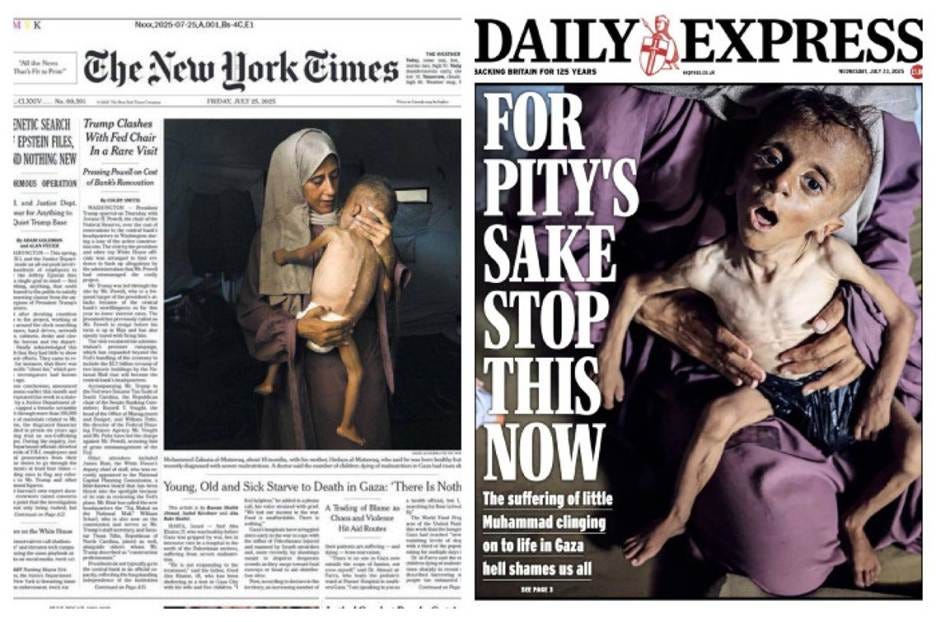
It is a picture of Muhammad Zakariya Ayyoub al-Matouq in Gaza City. Muhammad’s picture received huge exposure over the last few days, first in the Daily Express on July 23, then Sky News, CNN, NYT, BBC, the Guardian, and others picked it up. When the BBC interviewed the photographer who works for a Turkish state-run news agency (hardly an objective source), he said the photo shows “extreme hunger that babies and children are suffering from in the Gaza strip.” But like Osama, there is much more to this story that mainstream media again elected to ignore, or did not know, in its rush to slam Israel.
It turns out that Muhammad suffers from cerebral palsy, has hypoxemia, and was born with a serious genetic disorder per a medical report cited by David Collier from May 2025 and has required nutritional supplements since birth. A medical report Collier exposed, issued in Gaza in May 2025, confirms all of this. Furthermore, in another picture that was cropped to hide another aspect of the story, Muhammad’s brother appears without any evidence of malnutrition.
I don’t for a moment wish to leave you with the impression that Muhammad is not suffering from increasing malnutrition directly related to the difficulties the war in Gaza causes for treating his susceptibility to starvation. But the picture is not representative of the common condition of children in Gaza. And to the extent that it is probative, like the one of Osama, it should cause outrage directed at Hamas and the international organizations more so (or at least equally for those that do not totally share my perspective) to that directed at Israel.
Israel Made a Mistake
Simply put, Israel is fighting two wars—one is a hot war on many fronts in which bullets and bombs take the lives of the participants. The other is an information war in which words and images cut deeply into Israel’s support and its supporters’ souls. Both carry with them an existential risk for the Jewish State. In the hot wars since October 7, 2023, Israel has had much success, albeit not as much in Gaza as elsewhere. However, in the information war, Israel has failed—some because of conditions and attitudes beyond its control—but some because of self-inflicted wounds.
In the information war over hunger in Gaza, it is those self-inflicted wounds that have led to a dangerous situation that imperils much of what has been won through perseverance and at the cost of far too many IDF soldiers who have lost their lives and limbs to the effort. This is because what was once a snowball of starvation accusations rolling downhill that began soon after October 7 and that demonstrably had no merit now is now an avalanche of denunciations difficult to overcome.
Israel’s mistake was its decision to temporarily withhold humanitarian aid for two months after the latest ceasefire broke down in March 2025. This period lasted until May 19 when Israel’s security cabinet ordered full resumption of humanitarian aid to Gaza, through two channels, the GHF and the UN distribution system. But whether due to Netanyahu’s need to maintain his coalition or because of genuine desire to limit Hamas’ access to resources—or both—the March cutoff was a turning point. From then on, Israel rather than the international community owned the problem of feeding the Gazan people. Before that day, the availability of food in Gaza was not a significant issue. But when for two months Israel stopped third parties from sending food into Gaza under any condition, Israel took moral responsibility for what might happen next (whether that includes legal responsibility is a complicated and nuanced conversation) thus opening the door for criticism from those third parties that had previously been doing so that would prove hard to refute.
For sure, Israel did not stop the humanitarian deliveries to make Gazans suffer. It did so in a worthy attempt to impoverish Hamas and separate it from the Gazan people during a time when food was plentiful in Gaza. When Israel helped create and then supported the GHF, it did so in hopes of achieving those goals. But what I suspect Israel did not anticipate is that those UN agencies and NGOs that had been feeding the Gazan people would callously put their anti-Israel political agendas ahead of the needs of Gazans.
Nevertheless, Israel committed an unforced error by stopping the organizations from delivering aid. The GHF should have initiated operations while UN and other relief agency efforts were ongoing—not when they were asked to start up again. If Israel had done so, then there would have been no excuse for the other third-party efforts to stop, and we would not be where we are today.
Now, because of slanted reporting and pictures and video that is sometimes misleading, Israel is the target of an informational firestorm made worse by the fact that few will now believe its official statements refuting the allegations and more and more will suspect Israel’s motives. That is why the recent New York Times story that contained the headline, “No Proof Hamas Routinely Stole U.N. Aid, Israeli Military Officials Say” was so troubling. It was ostensibly based on two senior military officials and two other Israelis involved with the issue. None are named and none are directly quoted. In it, the reporter makes the following points germane to the title of the article:
The original UN aid operation was “relatively” reliable and “less vulnerable” to Hamas hijacking than that of other groups bringing aid into Gaza (no argument from me and little to this date from Israel as far as I can tell) but made a point of saying that Hamas did steal from other relief organizations on the ground.
There was no evidence that Hamas “regularly” stole from the UN which provided “the largest chunk of the aid.” But what does “regularly” mean and how much is the “largest chunk.” The answers to those questions are not provided and presumably vary. My best guess based on researching the issue is that the UN provided around half of the aid that flowed into Gaza before the GHF got involved. That left plenty of room for Hamas to have stolen all it needed from the other NGOs.
And although the article does refer to internal Hamas documents recovered by the IDF, it does not provide the details within them that include:
Throughout the war Hamas diverted at different times from 15% to 25% of incoming humanitarian aid for its purposes.
Hamas smuggled into Gaza higher value goods through the aid convoys, such as cigarettes, that it could sell.
Hamas used taxes and extortion/protection schemes to raise money from business within Gaza selling humanitarian aid.
The New York Times article also does not address why Hamas is now fighting so hard to stop the GHF from providing food, both as part of its hostage negotiations and in the field through murdering GHF employees, threatening others, and setting off riotous activity resulting in IDF defensive measures that have taken Gazan lives and been falsely portrayed in the media as proof of Israel’s genocidal intent.
So, the unrebutted truth is that Hamas stole humanitarian aid. Another truth might be that there is not proof that Hamas “regularly” stole from UN distribution mechanisms. That does not mean it did not happen. It just means that the degree of it has not been proven. What a surprise given that the UN relief organizations are riddled in Gaza with Hamas operatives. I doubt that they would tell the truth about what they stole!
Similarly, a USAID report cited by the Times reporter and other news outlets has been used to suggest that Israel is not being truthful regarding Hamas’ hijacking of food aid. But that report noted within it that that because aid recipients cannot be vetted, supplies could have reached Hamas administrative officials without detection. Furthermore, the drafters of the report relied entirely on self-reporting from aid organizations operating in what has been described a "mafia-like" environment controlled by Hamas through violence and intimidation—certainly not a situation conducive to reporting Hamas’ misconduct. Additionally, because the drafters lost access to classified intelligence systems during USAID's recent dismantlement, they potentially did not see crucial intelligence reports on Hamas diversions. And one source with knowledge of the study cautioned that lack of reports of widespread aid diversion by Hamas “does not mean that diversion has not occurred.” Furthermore, numerous reports and videos verify Hamas terrorists took control of food trucks and there are recordings of Gaza residents telling Israeli officials that run contrary to what the USAID report asserts. Even Palestinian Authority officials have contradicted the USAID’s findings when in April 2025, PA President Mahmoud Abbas blamed Hamas for looting aid. And, of course, both the Israeli and US government have loudly and clearly stated otherwise. Nevertheless, CNN and other organizations led their reporting of the report with headlines reporting as fact what is nuanced. CNN’s headline was “US government review found no evidence of widespread Hamas theft of Gaza aid.” So misleading in that the US government’s official position contradicted the headline and the questionable non-definitive findings of the report issued from an agency that days later was dissolved for reasons unrelated to its writing.
What is Happening Now
In recognition of mounting international criticism, Israel announced three steps that took effect on July 27 for alleviating the crisis:
Israel declared a “tactical pause” in military operations for ten hours daily, between 10:00 am and 8 pm, in parts of Gaza that include Gaza City, Deir al-Balah, and Muwasi (see map below). This is an unheard-of concession by a combatant during a war that will likely cost IDF soldier lives.
Israel opened secure aid corridors for deliveries that will remain open for seventeen hours from 6:00 AM to 11:00 PM.
Israel initiated airdrops of humanitarian aid.
Now, whether because of Israel’s initiatives or media exposure of their craven refusal to do their job, the other aid organizations have increased their humanitarian operations. On July 27, they delivered 100 truckloads of aid to Gazans in addition to that which GHF brings in. More appears to be on the way. And do not be influenced by commentators that suggest this is a drop in the bucket because before the war started 500 trucks made their way into Gaza every day. Per Andrew Fox’s analysis (a well-respected commentator), only an average of 75 out of those 500 trucks contained food (more than that is now necessary—perhaps a 100—because Gaza now does not produce food locally). The rest contained other items used in Gaza’s prewar economy per a United Nations Office of Humanitarian Affairs report in 2023. Those items included fuel and construction materials (do you have any suspicions where those construction materials went? I do.).
Where Might All This Lead?
It appears that Israel has now made the wise decision to do whatever is needed to convince the humanitarian organizations to start operating again. Whether that will result in a demonstrable flood of aid as opposed to providing just enough remains to be seen. However, it surely will enhance Hamas’ strength and influence in Gaza. And it will not repair the increased damage done to Israel’s standing in the international community through misinformation and genuine Gazan suffering, although it might slow a further slide.
As for the hostages, it means little other than further captivity. Hamas has no incentive to release them and has seen how easy it is by turning the screws on the Gazan people to increase pressure on Israel to agree to a permanent ceasefire that leaves Hamas intact in Gaza. I see this as an intolerable situation for Israel that will leave it having to make an excruciating but perhaps necessary decision to root out Hamas in its remaining enclaves with quick and decisive military action. That will cost soldiers’ lives and possibly the lives of some or all the remaining live hostages. It will also cost the lives of many Gazan civilians. But while in the short run that is all difficult to contemplate, it might well be the best solution for the long term.
What Can We Do?
Do not take headlines, pictures and videos at face value. At best, they accurately portray a small segment of the problem. At worst, they are propaganda pieces designed to vilify rather than illuminate. Also be aware that plenty of images and videos exist of Gazan food markets with lots of food and of looting trucks, etc. But mainstream media does not show them. Therefore, let’s not make this a war of images and videos designed to provoke our emotions. Be empathetic but be governed by reason.
If an article makes an outrageous accusation double and triple check with other sources that provide different perspectives than the one making the accusations. Thus, fact checking on CNN what the New York Times says does no good. And of course, the same is true in reverse. If a claim is made that is over-the-top in favor of Israel, fact check that too with sources that don’t usually take that position.
Recognize, that if the world turns against Hamas that can make a difference and that we can play a role in that with that through our advocacy no matter how hopeless it might seem. Remember what I always say, from a ripple comes a wave.
Meanwhile, there will be a lot of suffering because the world is giving Hamas’ evil a pass.
That’s shameful.
A Special Request
If you think this article of value, please share it with others. Please also consider indicating if you see value in the article by “liking” it or adding a comment. Doing so helps me determine the subject of future articles that you might find beneficial and, through social media, broadcasts my work to a wider audience.
Battlefield Decision in the Iron Sword War—Written by Brig. Gen. (res) Dr. Meir Finkel for The Begin-Sadat Center for Strategic Studies—July 23, 2025
Making Sure Damascus Learns the Right Lessons from the Suwayda Clashes—Written by Andrew Tabler—July 21, 2025
Time is Short to Trigger the Iran Nuclear Deal’s Snapback Mechanism—Written by Andrea Stricker for The Foundation for Defense of Democracies—July 24, 2025
Largest Teachers' Union in United States Erases Jews From the Holocaust—Written by Alana Goodman for The Washington Free Beacon—July 23, 2025
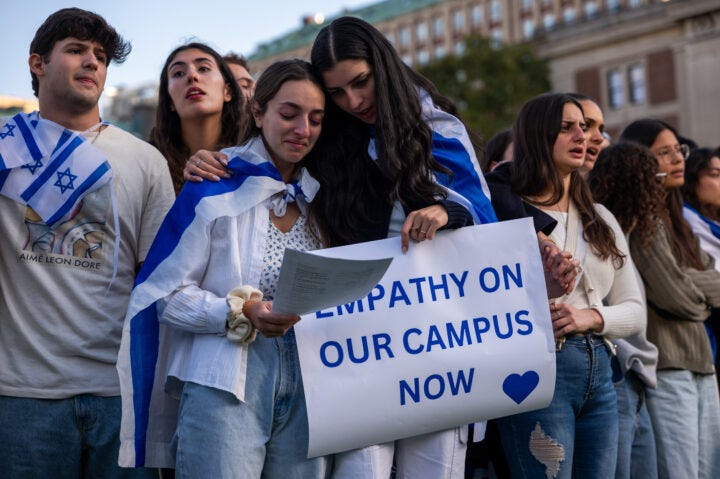
The Myth of a Divided Jewish America: What the Data Really Shows—Written by Josh Kraushaar for Jewish Insider—July 23, 2025
'Hezbollah Wanted to Slaughter Us and Rape our Women—We’re Too Merciful to Them'—Written by Yair Kraus for Ynet News—July 19, 2025
Israel’s Struggle with Hezbollah—A War Without End is now available in eBook and hardback format on Amazon and IngramSpark. This compelling narrative explores Hezbollah’s origins and cancerous growth, traces Israel’s response, and reveals Israel’s present readiness to meet Hezbollah’s challenge.
Cliff Sobin
Important Link—Alma Research and Education Center: Understanding the Security Challenges on Israel’s Northern Border




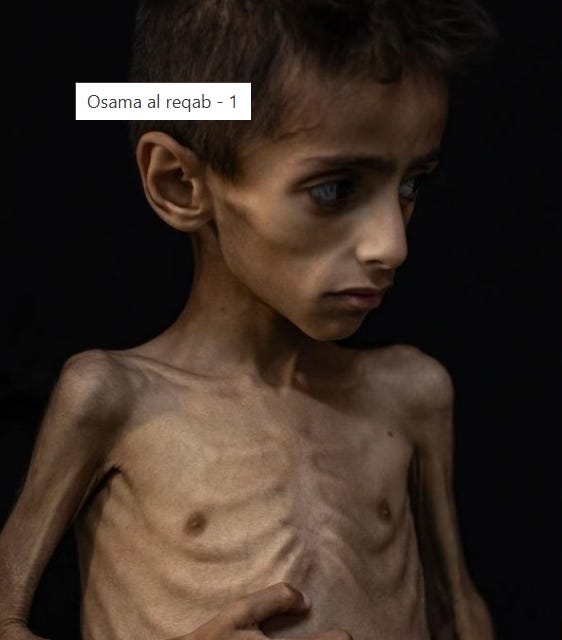
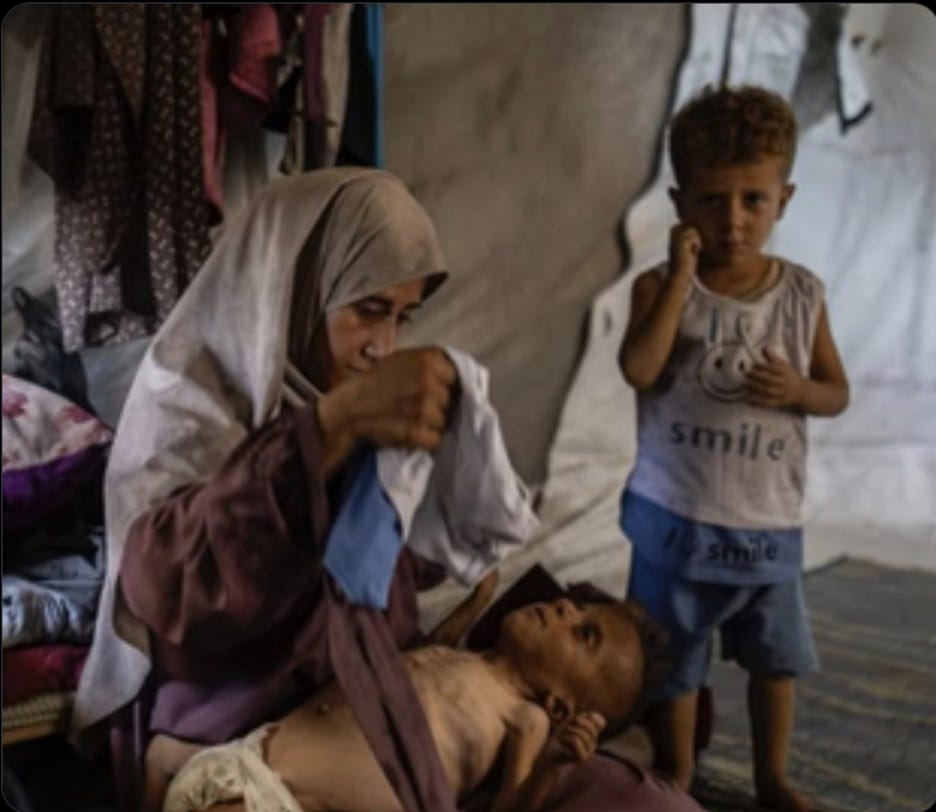

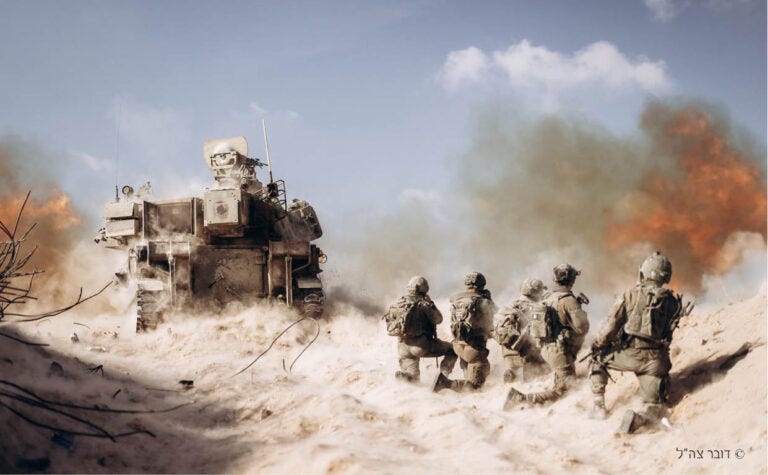
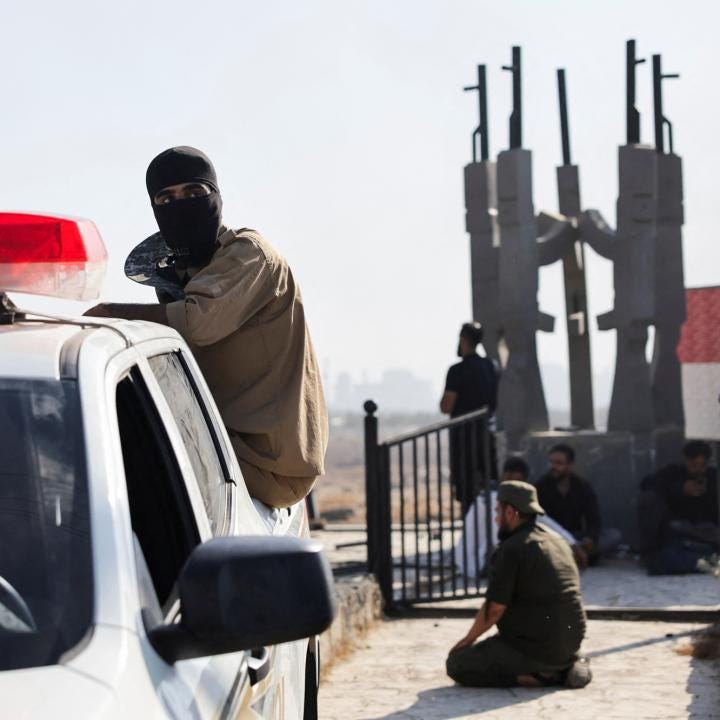





https://substack.com/@reeceashdown/note/c-140352808?r=5qrbeg&utm_medium=ios&utm_source=notes-share-action
Thank you for this.